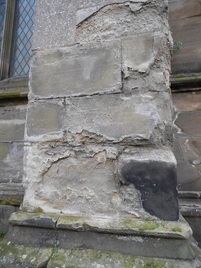
I reached out to the nearest buttress, grasped a handful of stone, and showed it to Bishop John.
Then I closed my fingers and squeezed it gently.
It dissolved into sand. The grains trickled through my fingers. Some of them sprinkled onto the bonnet of the Bishop's shiny almost-new car, sounding disproportionately noisy in the quiet of the evening. (OK, it wasn't quite sandblasting, but you get the idea.)
'That's what this building is made of.'
Sand.
The foolish man built his house upon the sand. My Victorian predecessor, the Revd John Craig, would have been familiar with those Gospel words. He'd have known that the wise man built his house upon the rock. Nevertheless, he chose to build the house of God out of sand. All Saints is an ecclesiastical sandcastle - albeit a very impressive one.
Later, I reflected. The entire Church is made of sand. Not just our magnificent building, with its lamentably soft Warwick sandstone construction, but the Church as the People of God. The Church is made up of human beings, all of us flawed, all of us carrying a weak and sinful nature, We're called to be like 'living stones', built by God into a spiritual house (1 Peter 2.5); but the stones of our lives are so often crumbly and unreliable - or, at the opposite end of the spectrum, so hard as to be unworkable. We do things wrong. We get into pointless arguments. We collapse under pressure. We fail to persevere when times are hard - or when they're easy - or when they're merely indifferent.
Yet that isn't the end of the story. Just as scientists recently developed a chocolate teapot which really can be used to make tea, so the Church can live and work and grow despite the poverty of the materials used. Moreover, it has two thousand years' experience of doing so. The whole is far greater, holier, and more effective than the sum of the parts. Together, we can surpass ourselves, and become nothing less than the Body of Christ in the world - broken, certainly, but even (and perhaps only) in our brokenness, able to share the good news of his redeeming love.
There is a caveat, of course. The foundations have to be in place. The Church is built on the foundations of the apostles and prophets, with Christ Jesus himself being the chief corner-stone (Ephesians 2.20). But when that's secure, even the mediocre building materials of our lives can be shaped into something miraculous: the earthly temple of the eternal God.
Then I closed my fingers and squeezed it gently.
It dissolved into sand. The grains trickled through my fingers. Some of them sprinkled onto the bonnet of the Bishop's shiny almost-new car, sounding disproportionately noisy in the quiet of the evening. (OK, it wasn't quite sandblasting, but you get the idea.)
'That's what this building is made of.'
Sand.
The foolish man built his house upon the sand. My Victorian predecessor, the Revd John Craig, would have been familiar with those Gospel words. He'd have known that the wise man built his house upon the rock. Nevertheless, he chose to build the house of God out of sand. All Saints is an ecclesiastical sandcastle - albeit a very impressive one.
Later, I reflected. The entire Church is made of sand. Not just our magnificent building, with its lamentably soft Warwick sandstone construction, but the Church as the People of God. The Church is made up of human beings, all of us flawed, all of us carrying a weak and sinful nature, We're called to be like 'living stones', built by God into a spiritual house (1 Peter 2.5); but the stones of our lives are so often crumbly and unreliable - or, at the opposite end of the spectrum, so hard as to be unworkable. We do things wrong. We get into pointless arguments. We collapse under pressure. We fail to persevere when times are hard - or when they're easy - or when they're merely indifferent.
Yet that isn't the end of the story. Just as scientists recently developed a chocolate teapot which really can be used to make tea, so the Church can live and work and grow despite the poverty of the materials used. Moreover, it has two thousand years' experience of doing so. The whole is far greater, holier, and more effective than the sum of the parts. Together, we can surpass ourselves, and become nothing less than the Body of Christ in the world - broken, certainly, but even (and perhaps only) in our brokenness, able to share the good news of his redeeming love.
There is a caveat, of course. The foundations have to be in place. The Church is built on the foundations of the apostles and prophets, with Christ Jesus himself being the chief corner-stone (Ephesians 2.20). But when that's secure, even the mediocre building materials of our lives can be shaped into something miraculous: the earthly temple of the eternal God.
 RSS Feed
RSS Feed